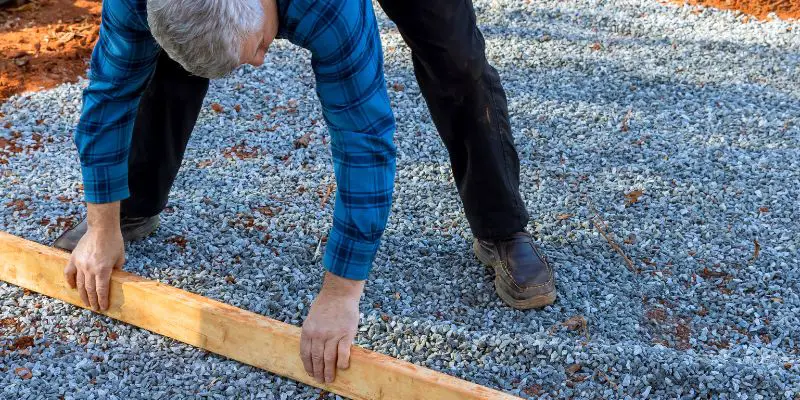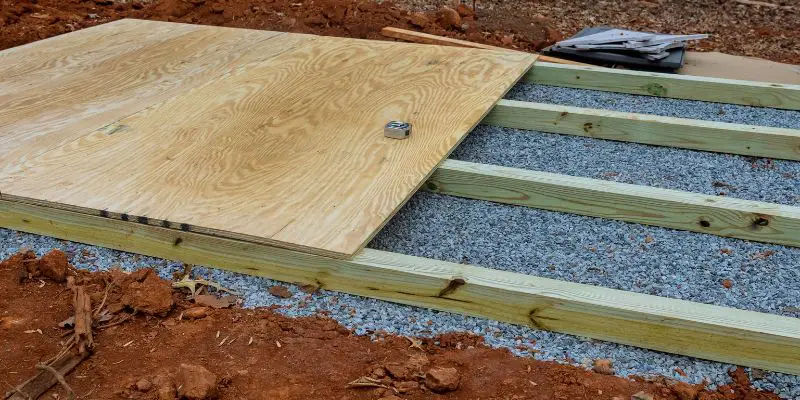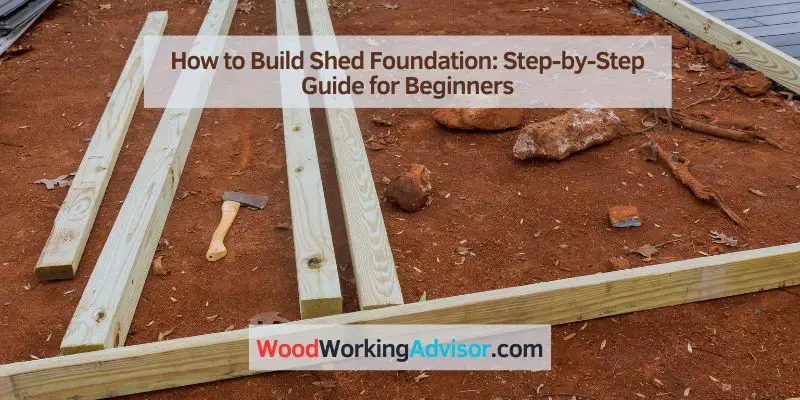To build a shed foundation, start by clearing the area and leveling the ground. Then, lay down gravel and use stakes and boards to frame the foundation.
After that, pour and level the concrete to create a solid base for the shed. Building a solid foundation for your shed is essential to ensure its stability and longevity. Proper preparation and construction are crucial to avoid any issues with the building over time.
By following the steps outlined for building a shed foundation, you can create a sturdy base that will support your shed for years to come. With the right materials, tools, and techniques, you can successfully build a durable and reliable foundation for your shed.
Assessing Location And Size
Assessing the location and size is a critical first step when building a shed foundation. This process involves evaluating the local building regulations, selecting a suitable area, and determining the shed’s purpose to establish its size.

Consider Local Building Regulations For Sheds
Before constructing a shed foundation, it’s essential to review the local building regulations and zoning codes. Check for any restrictions on the size, location, or construction materials of the shed. Adhering to these regulations will ensure compliance and prevent any potential legal issues in the future.
Choose A Flat, Well-drained Area
When selecting a location for the shed, prioritize a flat and well-drained area to prevent water accumulation and potential damage to the foundation. Ensure that the ground is level and free from any obstacles or obstructions that could hinder the construction process.
Determine The Shed’s Purpose To Decide On The Size
Understanding the intended use of the shed is crucial in determining its size. Whether it’s for storage, a workshop, or other purposes, the size of the shed should accommodate its functionality. Consider the dimensions required for storing equipment, tools, or other items to ensure the shed meets your specific needs.
Selecting Foundation Type
When it comes to building a shed, selecting the right foundation type is crucial for its durability and stability. There are various types of shed foundations, each with its own set of pros and cons. Matching the foundation to the shed size and soil type is essential to ensure a strong and lasting base for your shed.
Pros And Cons Of Different Foundation Types
Before deciding on a foundation type for your shed, it’s important to consider the advantages and limitations of each option. Below is a comparison of some common shed foundation types:
| Foundation Type | Pros | Cons |
|---|---|---|
| Concrete Slab | Permanent and stable | Expensive and labor-intensive to install |
| Gravel Pad | Good drainage and cost-effective | May require periodic maintenance |
| Pressure-Treated Skids | Easy and quick to install | Less stable compared to other options |
Matching Foundation To Shed Size And Soil Type
When selecting a foundation type, it’s important to match it to the size of your shed and the soil type of your location:
- Shed Size: Larger sheds typically require stronger and more stable foundations, such as a concrete slab, to support the weight and size of the structure. Smaller sheds may be adequately supported by gravel pads or pressure-treated skids.
- Soil Type: Different soil types have varying drainage and stability characteristics. In areas with high water table or unstable soil, a concrete slab foundation may be more suitable to prevent shifting or sinking.Always consider the specific requirements of your shed and the environmental conditions of your location when selecting the foundation type.
Gathering Materials And Tools
When it comes to tackling a shed build, it’s essential to start with a sturdy foundation. Gathering the right materials and tools is the first step towards building a durable and weather-resistant foundation for your shed. Before diving into the construction process, it’s important to have a comprehensive list of necessary supplies and choose durable and weather-resistant materials. Here’s a guide to help you gather the essential materials and tools for your shed foundation.
Comprehensive List Of Necessary Supplies
- Concrete blocks or pressure-treated lumber
- Gravel
- Landscape fabric
- Stakes and string
- Tape measure
- Level
- Shovel
- Wheelbarrow
- Compactor
- Hammer
- Drill with masonry bit
Durable And Weather-resistant Material Suggestions
When it comes to building a shed foundation, using durable and weather-resistant materials is crucial for ensuring the longevity of the structure. Opt for materials that can withstand varying weather conditions and moisture without deteriorating. Some durable and weather-resistant material suggestions include:
| Materials | Advantages |
|---|---|
| Pressure-treated lumber | Resistant to decay and insect damage |
| Concrete blocks | Excellent load-bearing capacity and durability |
| Gravel | Provides drainage and stability |
| Landscape fabric | Controls weeds and prevents soil erosion |
Lay Out And Level The Site
When building a shed, laying out and leveling the site is a crucial step that sets the foundation for the entire structure. Getting this phase right ensures stability, durability, and functionality. Here are the key steps to follow when laying out and leveling the site for your shed foundation.
Ground Marking Techniques For Foundation Layout
Before starting the construction of your shed foundation, it’s essential to mark out the ground to establish the exact areas where the foundation will be laid. Ground marking techniques may include using stakes and string to outline the perimeter of the shed. Make sure to measure and mark all corners precisely to ensure accuracy.
Instructions For Soil Excavation And Leveling
Excavating and leveling the soil is the next critical step in preparing the site for the shed foundation. Begin by excavating the marked area to the required depth, removing any debris or rocks that may cause an uneven foundation. Use a shovel or a backhoe to carefully level the soil, ensuring it’s compacted and even throughout the entire area where the foundation will be placed.
Setting Foundation Framework
Welcome to the crucial phase of setting the foundation framework for your shed. This step involves assembling the foundation frame according to the pre-determined plans. Once assembled, it’s imperative to secure the frame in place with appropriate anchoring, ensuring stability and durability. Let’s delve into the specifics of this significant stage.
Assemble The Foundation Frame According To Plans
Begin by carefully following the plans for your shed’s foundation frame. Ensure that the measurements are accurate and the materials are of high quality. Flawless execution in this step will set the stage for a sturdy and enduring shed foundation.
Secure The Frame In Place With Appropriate Anchoring
Proper anchoring is crucial to the stability of the shed’s foundation. Utilize suitable anchors to firmly secure the frame in place. This will safeguard the structure against external forces, such as wind and shifting soil, ensuring its longevity.

Pouring Concrete Or Installing Piers
When building a shed, one of the crucial decisions to make is whether to pour concrete or install piers for the foundation. Both methods have their pros and cons, and by understanding the step-by-step process of each, you can make an informed decision that best suits your shed’s needs.
Step-by-step Guide On Mixing And Pouring Concrete
Creating a solid concrete foundation for your shed involves meticulous planning and execution. Here’s a step-by-step guide to guide you through the process.
- Prepare the area: Clear the site of any debris or vegetation, ensuring the ground is level and compacted to provide a sturdy base.
- Formwork: Construct formwork using boards to contain the concrete and give the foundation its intended shape and size.
- Mixing concrete: Mix concrete according to the manufacturer’s instructions, ensuring the right proportions of cement, aggregate, and water are proportioned precisely.
- Pouring concrete: Carefully pour the mixed concrete into the formwork, ensuring it reaches all corners and levels evenly.
- Finishing: With a trowel, smoothen the surface of the concrete to achieve a professional finish.
Anchoring Shed Piers For Non-concrete Foundations
If opting for a non-concrete foundation, shed piers provide a sturdy alternative. Here’s a breakdown of how to anchor shed piers:
- Site preparation: Clear the area of any vegetation and level the ground to create a firm base for the piers.
- Choosing the right piers: Select the appropriate shed piers based on the soil type and the size and weight of your shed.
- Installation: Dig holes for the piers, ensuring they are placed at precise intervals as recommended by the manufacturer. Anchor the piers securely using concrete or gravel, depending on the soil type.
- Placement: Place the shed frame onto the secured piers, ensuring they are evenly spaced and leveled.
Inspecting And Finishing Touches
After completing the construction of your shed foundation, it’s crucial to carry out a thorough inspection and implement finishing touches to ensure durability and longevity. Proper inspection and finishing touches are key to maintaining the structural integrity of your shed foundation in the long run.
Checklist For Post-build Inspection
Performing a comprehensive post-build inspection is essential to identify any potential issues or areas that may require additional attention. Utilize the following checklist to facilitate a thorough post-build inspection:
- Check for uneven settling or shifting of the foundation
- Inspect the drainage system to ensure it effectively redirects water away from the foundation
- Examine the anchoring and support elements for any signs of damage or instability
- Verify that the foundation is level and properly aligned
- Assess the overall integrity of the concrete or blockwork for any cracks or deterioration
Recommendations For Longevity And Maintenance
To prolong the lifespan of your shed foundation and minimize maintenance requirements, consider implementing the following recommendations:
- Proper drainage: Ensure the surrounding area is graded to direct water away from the foundation to prevent water accumulation and potential damage.
- Regular inspections: Schedule periodic inspections to detect and address any issues before they escalate.
- Surface sealing: Apply a concrete sealer to protect the foundation from moisture penetration and reduce the risk of cracking.
- Vegetation management: Keep vegetation and roots away from the foundation to prevent potential structural damage.
Prep For Shed Assembly
Preparing The Site For Actual Shed Construction
Before assembling your shed, proper site preparation is crucial to ensure a stable foundation. Start by clearing the area from any debris, rocks, and vegetation, and ensure the ground is level. Using a shovel, remove any high spots and fill in low spots to create a flat surface for the foundation.
Tips For Ensuring The Foundation Is Ready To Support The Shed
- Consider using a pressure-treated lumber for the foundation frame to prevent water damage and rot.
- Compact the soil to avoid shifting or sinking of the foundation over time.
- Check the local building codes and regulations before beginning the construction to ensure compliance.
- Use a layer of gravel or crushed stone to improve drainage and prevent moisture buildup underneath the shed.
Frequently Asked Questions For How To Build Shed Foundation
What Is The Best Foundation For A Shed?
The best foundation for a shed is a concrete slab or pavers laid on a well-prepared, level ground. This provides stability and prevents shifting. Gravel or crushed stone can also work as a cost-effective option. Ensure proper drainage to prevent water accumulation.
What Is The Cheapest Way To Build A Shed Foundation?
The cheapest way to build a shed foundation is by using a gravel or crushed stone base. Level the ground, lay down landscape fabric, add a layer of gravel, and compact it. This provides a stable and affordable foundation for your shed.
How Do You Build A Strong Foundation For A Shed?
To build a strong foundation for a shed, start by leveling the ground. Use gravel or crushed stone to create a base. Then, construct a frame using pressure-treated lumber and anchor it securely. Finally, fill the frame with concrete for a solid foundation.
Do You Need A Slab Foundation For A Shed?
Yes, a shed typically needs a slab foundation for stability and durability. A concrete slab provides a solid base for the shed to sit on, preventing shifting or sinking. It also helps to protect the shed from moisture and pests.
Conclusion
A solid shed foundation is crucial for durability and stability. By following these steps, you can ensure a level and sturdy base for your shed. Remember to consider the local climate and soil conditions when selecting your foundation type. With the right approach, your shed will be well-equipped to withstand the test of time.



One thought on “How to Build Shed Foundation: Step-by-Step Guide for Beginners”